WORX Pole Saw WA0222 Instruction Manual
PRODUCT SAFETY
WARNING: Some dust created by power sanding, sawing, grinding, drilling and other construction activities contains chemicals known to the State of California to cause cancer, birth defects or other reproductive harm. Some examples of these chemicals are:
- Lead from lead-based paints;
- Crystalline silica from bricks and cement and other masonry products;
- Arsenic and chromium from chemically-treated lumber.
Your risk from these exposures varies, depending on how often you do this type of work. To reduce your exposure to these chemicals: work in a well ventilated area, and work with approved safety equipment, such as those dust masks that are specially designed to filter out microscopic particles.
WARNING: This product can expose you to chemicals including lead and Di(2- ethylhexyl)phthalate (DEHP) which are known to the State of California to cause cancer and birth defects or other reproductive harm. For more information go to www.P65Warnings. ca.gov.
Important Safety Instructions
WARNING: Read all safety warnings and instructions. Failure to follow the warnings and instructions may result in electric shock, fire and/or serious injury.
FOR ALL APPLIANCES:
- Avoid Dangerous Environment – Don’t use appliances in damp or wet locations.
- Don’t Use In Rain.
- Keep Children Away – All visitors should be kept at a distance from work area.
- Dress Properly – Do not wear loose clothing or jewelry. They can be caught in moving parts.Use of rubber gloves and substantial footwear is recommended when working outdoors. Wear protective hair covering to contain long hair.
- Use Safety Glasses – Always use face or dust mask if operation is dusty.
- Use Right Appliance – Do not use appliance for any job except that for which it is intended.
- Don’t grasp the exposed cutting blades or cutting edges when picking up or holding the appliance.
- Don’t Force Appliance – It will do the job better and with less likelihood of a risk of injury at the rate for which it was designed.
- Don’t Overreach – Keep proper footing and balance at all times.
- Stay Alert – Watch what you are doing. Use common sense. Do not operate appliance when you are tired.
- Store Idle Appliances Indoors – When not in use, appliances should be stored indoors in dry, and high or locked-up place – out of reach of children.
- Maintain Appliance With Care – Keep cutting edge sharp and clean for best performance and to reduce the risk of injury. Follow instructions for lubricating and changing accessories. Keep handles dry, clean, and free from oil and grease.
- Check Damaged Parts – Before further use of the appliance, a guard or other part that is damaged should be carefully checked to determine that it will operate properly and perform its intended function. Check for alignment of moving parts, binding of moving parts, breakage of parts, mounting, and any other condition that may affect its operation. A guard or other part that is damaged should be properly repaired or replaced by an authorized service center unless indicated elsewhere in this manual.
FOR ALL BATTERY – OPERATED GARDENING APPLIANCES:
- Prevent unintentional starting. Ensure the switch is in the off-position before connecting to battery pack, picking up or carrying the appliance. Carrying the appliance with your finger on the switch or energizing appliance that have the switch on invites accidents.
- Disconnect the battery pack from the appliance before making any adjustments, changing accessories, or storing appliance. Such preventive safety measures reduce the risk of starting the appliance accidentally.
- Recharge only with the charger specified by the manufacturer .A charger that is suitable for one type of battery pack may create a risk of fire when used with another battery pack.
- Use appliances only with specifically designated battery packs. Use of any other battery packs may create a risk of injury and fire.
- When battery pack is not in use, keep it away from other metal objects, like paper clips, coins, keys, nails, screws or other small metal objects, that can make a connection from one terminal to another. Shorting the battery terminals together may cause burns or a fire.
- Under abusive conditions, liquid may be ejected from the battery; avoid contact. If contact accidentally occurs, flush with water. If liquid contacts eyes, additionally seek medical help. Liquid ejected from the battery may cause irritation or burns.
- Do not use a battery pack or appliance that is damaged or modified. Damaged or modified batteries may exhibit unpredictable behavior resulting in fire, explosion or risk of injury.
- Do not expose a battery pack or appliance to fire or excessive temperature. Exposure to fire or temperature above 130°C may cause explosion.
- Follow all charging instructions and do not charge the battery pack or appliance outside of the temperature range specified in the instructions. Charging improperly or at temperatures outside of the specified range may damage the battery and increase the risk of fire.
- Have servicing performed by a qualified repair person using only identical replacement parts.This will ensure that the safety of the product is maintained.
- Do not modify or attempt to repair the appliance orthe battery pack (as applicable) except as indicated in the instructions for use and care.
Pole saw safety warnings
WARNING – Do not operate near electrical power lines. The unit has not been designed to provide protection from electric shock in the event of contact with overhead electric lines, Consult local regulations for safe distances from overhead electric power lines and ensure that the operating position is safe and secure before operating the saw chain pole pruner.
- Keep all parts of the body away from the saw chain. Make sure the switch is off when clearing jammed material. Saw chain continues to move after the switch is turned off. A moment of inattention while operating the pole pruner may result in serious personal injury.
- Carry the pole pruner by the handle with the saw chain stopped. When transporting or storing the pole pruner, always fit the saw chain device cover. Proper handling of the pole pruner will reduce possible personal injury from the saw chain.
- Hold the pole pruner by insulated gripping surfaces only, because the saw chain may contact hidden wiring or its own cord. A saw chain contacting a “live” wire may make exposed metal parts of the pole pruner “live” and could give the operator an electric shock.
- Keep cable away from cutting area. During operation the cable may be hidden in shrubs and can be accidentally cut by the saw chain.
- Do not use the pole pruner in bad weather conditions, especially when there is a risk of lightning. This decreases the risk of being struck by lightning.
- To reduce the risk of electrocution, never use near any electrical power lines. Contact with or use near power lines may cause serious injury or electric shock resulting in death.
- Always use two hands when operating the pole pruner. Hold the pole pruner with both hands to avoid loss of control.
- Always use head protection when operating the pole pruner overhead. Falling debris can result in serious personal injury.
SAFETY WARNINGS FOR BATTERY PACK
- Do not dismantle, open or shred battery pack.
- Do not expose battery pack to heat or fire. Avoid storage in direct sunlight.
- Do not short-circuit a battery pack. Do not store battery packs haphazardly in a box or drawer where they may short-circuit each other or be short-circuited by other metal objects. When battery pack is not in use, keep it away from other metal objects, like paper clips, coins, keys, nails, screws or other small metal objects, that can make a connection from one terminal to another. Shorting the battery terminals together may cause burns or fire.
- Do not remove battery pack from its original packaging until required for use.
- Do not subject battery pack to mechanical shock.
- In the event of battery leaking, do not allow the liquid to come in contact with the skin or eyes. If contact has been made, wash the affected area with copious amounts of water and seek medical advice.
- Observe the plus (+) and minus (–) marks on the battery back and equipment and ensure correct use.
- Do not use any battery pack which is not designed for use with the equipment.
- Keep battery pack out of the reach of children.
- Seek medical advice immediately if a cell or battery has been swallowed.
- Always purchase the battery pack recommended by the device manufacturer for the equipment.
- Keep battery pack clean and dry.
- Wipe the battery pack terminals with a clean dry cloth if they become dirty.
- Battery pack needs to be charged before use. Always use the correct charger and refer to the manufacturer’s instructions or equipment manual for proper charging instructions.
- Do not leave battery pack on prolonged charge when not in use.
- After extended periods of storage, it may be necessary to charge and discharge the battery pack several times to obtain maximum performance.
- Battery pack gives its best performance when it is operated at normal room temperature (20 °C ± 5 °C).
- When disposing of battery packs, keep battery packs of different electrochemical systems separate from each other.
- Recharge only with the charger specified by Worx. Do not use any charger other than that specifically provided for use with the equipment. A charger that is suitable for one type of battery pack may create a risk of fire when used with another battery pack.
- Retain the original product literature for future reference.
- Use only the battery pack in the application for which it was intended.
- Remove the battery pack from the equipment when not in use.
- Dispose of properly.
SYMBOLS
 |
To reduce the risk of injury, user must read instruction manual |
 |
Wear eye protection |
 |
Wear ear protection |
 |
Wear head protection |
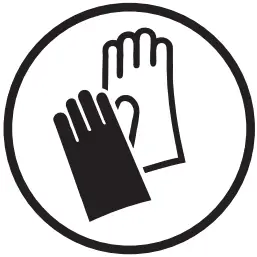 |
protective gloves |
 |
protective footwear |
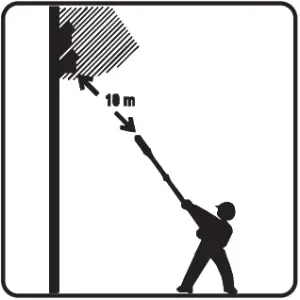 |
Warning of danger from overhead electric-power lines |
 |
Li-Ion battery, battery must be recycled |
 |
Do not burn |
 |
Batteries may enter water cycle if disposed improperly, which can be hazardous for ecosystem. Do not dispose of waste batteries as unsorted municipal waste. |
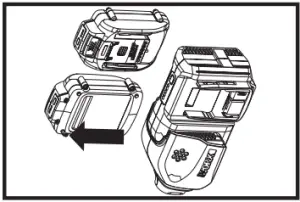 |
Remove battery from the socket before carrying out any adjustment, servicing or maintenance. |
 |
POSITEC Inc. has established a partnership with the RBRC Corporation to recycle any Positec batteries with the RBRC-call2recycle seal. For environmental protection, please do not discard batteries in the trash. After the batteries’ life cycle is ended, then please call 1-800-822-8837 for a free service that will properly dispose of the battery. |
COMPONENT LIST
- OIL FILLER CAP
- OIL TANK
- GUIDE BAR
- CHAIN
- BAR AND CHAIN SHEATH
- EXTENSION POLE

Not all the accessories illustrated or described are included in standard delivery.
TECHNICAL DATA
|
WA0222 |
|
|
Max. Cutting height |
12.5ft (3.8m) |
| Bar length |
10”(25cm) |
|
Chain speed |
55.8 ft/s (17m/s) |
| Number of chain drive links |
40 |
|
Chain gauge |
0.043” (1.1mm) |
|
Adaptive Chain type |
ES: 3/8.043-40E/ QIRUI : A0(T)- 40E/ OREGON: 90PX040G |
|
Adaptive Bar type |
ES: ES104SDEA041/ QIRUI : PO10-43SR(T) / OREGON: 104MLEA041 |
|
Oil tank capacity |
130ml |
| Chain pitch |
3/8”(0.95cm) |
|
Machine weight |
4.06lbs (1.84kg) |
ACCESSORIES
|
WA0222 |
|
| Hex key: |
1 |
|
Extension pole: |
1 |
Only use the appropriate accessories intended for this tool. Accessory information can be found on the product packaging, at a Worx dealer or on our website at www.worx.com.
OPERATING INSTRUCTIONS
![]() NOTE: Before using the tool, read the instruction book carefully.
NOTE: Before using the tool, read the instruction book carefully.
Intend Use
This attachment is intended for sawing of trees, tree trunks, branches, limbs, etc. Cuts can be sawed with or across the grain. This product is not suitable for sawing mineral materials.
ASSEMBLY & OPERATION
ASSEMBLY
- Connecting Remove the existing attachment, and connect the pole saw attachment. Slip the attachment into the shaft of the main unit and secure in place with the locking knob. Place the saw on a solid, level surface before assembling. Before using, make sure it is well connected.See Fig. A
 Fig. A
Fig. AWARNING! Do not install the battery pack before it has been completely assembled. Always use gloves when handling the chain.
- Removing the bar and chain sheath.See Fig. B
 Fig. B
Fig. B - TENSIONING CHAINPlace the saw on any suitable flat surface. And turn the Chain Tensioning Knob clockwise until it is hand tight.NOTE: The tension is automatically increased while the Chain Tensioning Knob is being turned in a clockwise direction.
WARNING: The chain is not yet tensioned. Tensioning the chain applies as described under “TENSIONING CHAIN”. The chain now needs to be inspected to make sure it is properly tensioned.NOTE: New saw chains will stretch. Check the chain tension frequently when first used and tighten when the Chain becomes loose around the Guide Bar.
WARNING:
- Removing the battery pack before adjusting saw chain tension.
- Cutting edges on chain are sharp. Use protective gloves when handling chain.
- Maintain proper chain tension always. A loose chain will increase the risk of kickback. A loose chain may jump out of guide bar groove. This may injure operator and damage chain. A loose chain will cause chain, bar, and sprocket to wear rapidly.See Fig.C
 Fig. CNOTE: The Chain is properly tensioned when it can be lifted off of the Guide Bar and the drive link is within the rail of the Guide Bar.NOTE: The Chain will stretch while cutting and lose proper tension. When the chain becomes loose, completely unscrew the Chain Tensioning Knob, that is, to turn it in a counter-clockwise direction. And retighten it again.
Fig. CNOTE: The Chain is properly tensioned when it can be lifted off of the Guide Bar and the drive link is within the rail of the Guide Bar.NOTE: The Chain will stretch while cutting and lose proper tension. When the chain becomes loose, completely unscrew the Chain Tensioning Knob, that is, to turn it in a counter-clockwise direction. And retighten it again.
- Assembling the extension pole to the machine Connecting the extension pole to the pole saw. See Fig.D
 Fig. DNOTE: Make sure the extension pole is locked into position securely before operation.
Fig. DNOTE: Make sure the extension pole is locked into position securely before operation. - Attaching the shoulder strap Attach the shoulder strap to the hook on the pole with the included carabiner hook. See Fig.E
 Fig. E
Fig. E - Filling the oil tankWARNING: Removing the battery pack before filling the oil tank.
- Set the saw on any suitable surface with Oil Filler Cap facing upward.
- Clean area around the Oil Filler Cap with cloth and unscrew the cap by turning it counter clockwise.
- Add bar and chain oil (not included) until tank is full.
- Avoid dirt or debris entering oil tank, refit Oil Filler Cap and tighten by turning clockwise until hand tight.Important: To allow venting of the oil tank, small breather channels are provided between the Oil Filler Cap and the strainer, to prevent leakage, and ensure machine is left in a horizontal position (Oil Filler Cap uppermost) when not in use. It is important to use only the recommended standard bar and chain oil (Grade: ISO VG32) to avoid damage to the pole saw. This can be found at the location where you purchased this saw or your local hardware store. Never use recycled/ old oil. Use of non-approved oil will void the warranty.Do not swallow. If swallowed, call a physician immediately. Keep out of reach of children. Store away from heat or open flame. See Fig.F
 Fig. F
Fig. F
- OPERATIONCutting: See Fig.G
 Fig. G
Fig. G
LUBRICATION
Important: The pole saw is not filled with oil. It is essential to fill with oil before use. Never operate the pole saw without chain oil or at an empty oil tank level, as this will result in extensive damage to the product.NOTE: Chain life and cutting capacity depend on optimum lubrication. Therefore, the chain is automatically oiled during operation.
CUTTING
Important: Check the oil tank is filled prior to starting and regularly during operation. Refill oil when oil level is low. A full oil tank will last approx. 35 minutes of cutting depending on sawing intensity and stops.
Check recent replaced chain tension about every 10 minutes during operation.
- Installing the battery pack into the machine.
- Make sure section of log to be cut is not laying on the ground. This will keep the chain from touching the ground as it cuts through the log. Touching the ground while the Chain is moving is dangerous and will dull the Chain.
- Use both hands to grip saw. Use a firm grip. Thumbs and fingers must wrap around saw handles. (See Fig. G)
- Make sure your footing is firm. Keep feet-shoulder width apart. Distribute your weight evenly on both feet.
- When ready to make a cut, push the Lock-off Button and Switch Trigger completely. This will turn saw on. Releasing them will turn the saw off. Make sure the saw is running at full speed before starting a cut.
- When starting a cut, slowly place moving chain against the wood. The wood should be as close to the saw body as possible. Hold saw firmly in place to avoid possible bouncing or skating (sideways movement) of saw.
- Guide the saw using light pressure and do not put excessive force on the saw, letting the saw do its work. The motor will overload and can burn out. It will do the job better and safer at the rate for which it was intended.
- Remove the saw from a cut with the saw running at full speed. Stop the saw by releasing the lock-off button and switch trigger. Make sure the chain has stopped before setting the saw down.
- Keep practicing on scrap logs in a secure working area until you are comfortable, using a fluid motion and a steady cutting rate.
Kickback Safety Devices on This Saw
This saw has a low-kickback chain and reduced kickback Guide Bar. Both items reduce the chance of kickback. However, kickback can still occur with this saw.
The following steps will reduce the risk of kickback.
- Use both hands to grip saw while saw is running. Use firm grip. Thumbs and fingers must wrap around saw handles.
- Keep all safety items in place on saw. Make sure they work properly.
- Keep solid footing and balance at all times.
- Stand slightly to the left side of saw. This keeps your body from being in direct line with chain.
- Do not let Guide Bar nose touch anything when chain is moving.
- Never try cutting through two logs at same time. Only cut one log at a time.
- Do not bury the Guide Bar nose or try plunge cut (boring into wood using Guide Bar nose.
- Watch for shifting of wood or other forces that may pinch chain.
- Use extreme caution when re-entering a previous cut.
- Use only the low-kickback chain and Guide Bar that were supplied with this pole saw or recommended.
- Never use a dull or loose chain. Keep chain sharp with proper tension.
OPERATION FOR POLE SAW
Cutting with shoulder strap (See Fig. G) “Above”
The extension pole is supplied with a shoulder strap that gives extra support when hoisting the pole saw in the air. Hook the shoulder strap to the extension pole and wrap around your shoulder. The shoulder strap can also soften the impact if the pole saw is dropped after the completion of a cut.
Cutting with extension pole
- Install the battery pack into the machine.
- Before cutting a high branch, consider all the same points detailed in the previous section “Trimming Branches” but pay particular attention to the likely path of the falling branch.WARNING: Do not stand directly below a branch being cut. Keep bystanders far away. Do not stand on a ladder or other type of unstable support while using the tool. Do not use the tool near cable, electrical power or telephone lines. Keep 3m away from all power lines. (See Fig. H1-H4)






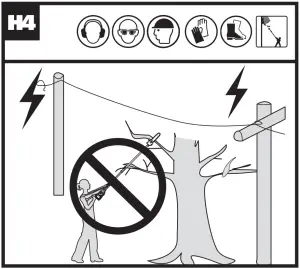
- Use both hands to grip Pole Saw. Use only designated grip areas when operating Pole Saw (See Fig. H5) Use firm grip. Thumbs and fingers must wrap around Pole Saw handle and pole.


- Make sure your footing is firm. Keep feet apart. Divide your weight evenly on both feet.
- When ready to make a cut, fully press the Lock-off Button and Switch Trigger. This will turn Pole Saw on. Releasing them will turn Pole Saw off. Make sure saw is running at full speed before starting a cut.
- When starting a cut, place moving chain against wood. Hold Pole Saw firmly in place to avoid possible bouncing or skating (sideways movement) of saw.
- Guide Pole Saw using light pressure. Do not force Pole Saw. The motor will overload and can burn out. It will do the job better and safer at the rate for which it was intended.
- Remove Pole Saw from a cut with saw running at full speed. Stop Pole Saw by releasing trigger. Make sure chain has stopped before setting Pole Saw down.
TRIMMING A TREE (PRUNING)
WARNING: Avoid kickback. Kickback can result in severe injury or death. See Kickback, to avoid risk of kickback.WARNING: Do not operate Pole Saw while
- in a tree
- on a ladder or any other unstable surface
- in any awkward position
You may lose control of Pole Saw causing severe injury.WARNING: Do not extend arms above shoulders when using Pole Saw.CAUTION: Seek professional help if facing conditions beyond your ability.Trimming a tree is the process of cutting limbs from a living tree. Make sure your footing is firm. Keep feet apart. Divide your weight evenly on both feet.
Follow directions below to trim a tree.
- Make first cut six inches from tree trunk on underside of limb. Use top of guide bar to make this cut. Cut 1/3 through diameter of limb (See Fig. H6).


- Move two to four inches farther out on limb. Make second cut from above limb. Continue cut until you cut limb off.
- Make third cut as close to tree trunk as possible on underside of limb stub. Use top of guide bar to make this cut. Cut 1/3 through diameter of stub.
- Make fourth cut directly above third cut. Cut down to meet third cut. This will remove limb stub.
SAW MAINTENANCE
Follow maintenance instructions in this manual. Proper cleaning of saw and chain and Guide Bar maintenance can reduce chances of kickback. Inspect and maintain saw after each use. This will increase the service life of your saw.
NOTE: Even with proper sharpening, risk of kickback can increase with each sharpening.
MAINTENANCE AND STORAGE OF POLE SAW
- Remove the battery pack
- When not in use
- Before moving from one place to another
- Before servicing
- Before changing accessories or attachments, such as saw chain and guard
- Inspect pole saw before and after each use. Check saw closely if guard or other part has been damaged. Check for any damage that may affect operator safety or operation of saw. Check for alignment or binding of moving parts. Check for broken or damaged parts. Do not use pole saw if damage affects safety or operation. Have damage repaired by authorized service center. To locate an authorized service center, visit www.worx.com.
- Maintain pole saw with care.
- Never expose saw to rain or direct moisture.
- Keep chain sharp, clean, and lubricated for better and safer performance.
- Follow steps outlined in this manual to sharpen chain.
- Keep handles dry, clean, and free of oil and grease.
- Keep all screws and nuts tight.
- When servicing, use only identical replacement parts.
- When not in use, always store pole saw
- in a high or locked place, out of children’s reach
- in a dry place
- with bar and chain sheath in place
Bar Maintenance
To maximize bar life, the following bar maintenance is recommended. The bar rails that carry the chain should be cleaned before storing the tool or if the bar or chain appear to be dirty. The rails should be cleaned every time the chain is removed.
TROUBLESHOOTING TABLE
The following table gives checks and actions that you can perform if your machine does not operate correctly. If these do not identify/remedy the problem, contact your service agent.
WARNING: Switch off and remove the battery pack before investigating fault.
|
Symptom |
Possible Cause |
Remedy |
| Pole saw fails to operate | Out of battery. Fuse faulty. | Charge the battery pack. Replace fuse. |
| Pole saw operates intermittently | Over heatingApplying too much pressure while cutting. Loose connection.Internal wiring defective. On/Off Trigger defective. | Place the machine in a cool, ventilated place to cool it downApplying relatively less pressure while cuttingContact service agent 1-866-354-Worx (9679). |
| Dry chain | No oil in reservoirVent in oil filler cap clogged Oil passage clogged | Refill oil Clean capClean oil passage outlet |
| Chain/chain bar over- heats | No oil in reservoirVent in oil filler cap clogged Oil passage cloggedChain is over tensioned Dull chain | Refill oil Clean capClean oil passage outlet Adjust chain tension Sharpen chain or replace |
| Pole saw rips, vibrates, does not saw properly | Chain tension too looseDull chainChain worn outChain teeth are facing in the wrong direction | Adjust chain tension Sharpen chain or replace Replace chainReassemble with chain in correct direction |
FOR BATTERY TOOLS
The ambient temperature range for the use and storage of tool and battery is 0đ-45đ (32°F 113°F).
The recommended ambient temperature range for the charging system during charging is 0đ-40đ (32°F-104°F).
Copyright © 2020, Positec. All Rights Reserved. AR01504300


References
[xyz-ips snippet=”download-snippet”]

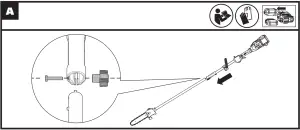 Fig. A
Fig. A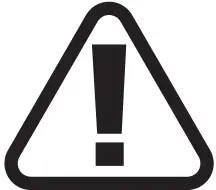 Fig. B
Fig. B Fig. DNOTE: Make sure the extension pole is locked into position securely before operation.
Fig. DNOTE: Make sure the extension pole is locked into position securely before operation.